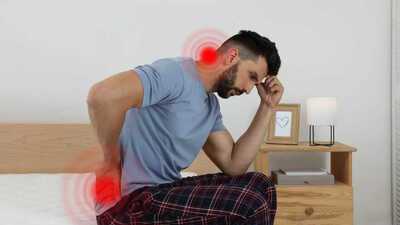You’ve probably heard that sleeping on your back is “good for posture” or helps prevent wrinkles. But recent medical research, including a New York Post article, suggests otherwise. For most adults, sleeping on your back might actually be the worst position for breathing, digestion, and even brain health. It can increase snoring, trigger sleep apnea, and affect how the brain clears waste while you sleep. While it may be helpful for some people with spinal issues, it’s far from the healthiest choice for everyone. Before assuming it’s the ideal sleep position, it’s worth knowing what science really says. No myths, no wellness fluff, just straightforward facts that might make you rethink the way you settle in for the night.
Why sleeping on your back is the worst for sleep apnea
Let’s start with the big one: obstructive sleep apnea (OSA). It’s one of the most serious sleep disorders, and more than 50 percent of people with OSA have what's known as positional OSA. That means their symptoms get significantly worse when they sleep on their backs. A clinical study published in Sleep and Breathing found that sleeping in the supine position can dramatically increase the apnea-hypopnea index (AHI), which measures how often breathing is disrupted during sleep. In contrast, side-sleeping lowered those numbers substantially. Simply put, sleeping on your back can be the worst position for your airway, especially if you’re already dealing with apnea-related issues. Switching sides isn’t just more comfortable, it could actually save your sleep.
Why sleeping on your back is the worst for acid reflux

Got heartburn at night? Your sleep position might be to blame. Multiple studies have shown that sleeping on your left side can significantly reduce acid exposure in the esophagus, helping relieve nighttime heartburn and GERD symptoms. On the flip side, lying flat on your back tends to make reflux worse by allowing stomach acid to flow more easily into the esophagus. A 2022 study published in Sleep Medicine Research confirmed this strong connection between sleep posture and nighttime reflux. If you regularly wake up with a burning sensation or bitter taste, switching to your left side could offer real relief, no medication required, just smarter sleeping.
Why sleeping on your back is the worst for brain detox
Your brain has a “clean-up crew” called the glymphatic system. It clears out waste like amyloid-β—stuff linked to Alzheimer’s. The catch? It works best when you sleep on your side. A 2015 study in Journal of Neuroscience used MRI imaging on animals and found that side-sleeping led to better brain waste clearance than back-sleeping.This research suggests that your sleep position may not just impact how rested you feel, but also how well your brain ages. So if long-term brain health is on your radar, turning to your side could be a smart move for your future self.
Why sleeping on your back is the worst for snoring (and relationships)
Let’s be honest: nobody wants to sleep next to a chainsaw. And if you sleep on your back, you might just become one. When you lie flat, gravity pulls your tongue and soft tissues backward, relaxing your airway muscles and narrowing your throat. This makes it much harder for air to flow smoothly, especially during deep sleep. The result? Loud, persistent snoring that can ruin your sleep and your partner’s sanity. For people with sleep apnea, this position can even cause breathing pauses that seriously impact health over time. Switching to your side or using a supportive pillow can make a huge difference in keeping those midnight motor noises at bay and helping you breathe better through the night.
Why sleeping on your back is the best if you’re a baby

There’s really only one group of people who should sleep on their backs, babies under 12 months. For infants, this position is actually life-saving, as it helps reduce the risk of sudden infant death syndrome (SIDS). But for the rest of us, back sleeping doesn’t hold the same benefits. Adults who struggle with sleep apnea, acid reflux, loud snoring, or even morning brain fog may find that lying on their back makes things worse. Side sleeping, especially on the left, can improve digestion, breathing, and circulation. So unless you're under a year old, switching your sleep position might be one of the easiest ways to feel more rested and function better during the day.
Why sleeping on your back is the worst when it comes to overall sleep quality
Side sleeping isn’t just better for your health, it can actually help you sleep more deeply. A 2023 observational study found that people who slept on their sides experienced longer REM cycles and woke up less often during the night. In contrast, those who slept on their backs had more frequent sleep disruptions, especially individuals dealing with breathing problems or gastrointestinal issues like acid reflux. The side position supports better airway stability and digestion, both of which contribute to more restful, uninterrupted sleep. So if you’re waking up groggy or tossing and turning, simply changing how you sleep could make a noticeable difference in your overall sleep quality.
How to stop sleeping on your back:

Sleeping on your back is one of the worst positions for your throat, stomach, brain function, and overall sleep quality. Unless you’re a baby or someone with specific spinal issues that require it, your body probably functions better on its side. From reduced snoring and reflux to better circulation and deeper REM cycles, the benefits of side sleeping are backed by solid science. If restful, healthy sleep is the goal, turning sideways might just be the simplest fix.
Also read| 5 reasons why your blood pressure medication is not working
Why sleeping on your back is the worst for sleep apnea
Let’s start with the big one: obstructive sleep apnea (OSA). It’s one of the most serious sleep disorders, and more than 50 percent of people with OSA have what's known as positional OSA. That means their symptoms get significantly worse when they sleep on their backs. A clinical study published in Sleep and Breathing found that sleeping in the supine position can dramatically increase the apnea-hypopnea index (AHI), which measures how often breathing is disrupted during sleep. In contrast, side-sleeping lowered those numbers substantially. Simply put, sleeping on your back can be the worst position for your airway, especially if you’re already dealing with apnea-related issues. Switching sides isn’t just more comfortable, it could actually save your sleep.
Why sleeping on your back is the worst for acid reflux
Got heartburn at night? Your sleep position might be to blame. Multiple studies have shown that sleeping on your left side can significantly reduce acid exposure in the esophagus, helping relieve nighttime heartburn and GERD symptoms. On the flip side, lying flat on your back tends to make reflux worse by allowing stomach acid to flow more easily into the esophagus. A 2022 study published in Sleep Medicine Research confirmed this strong connection between sleep posture and nighttime reflux. If you regularly wake up with a burning sensation or bitter taste, switching to your left side could offer real relief, no medication required, just smarter sleeping.
Why sleeping on your back is the worst for brain detox
Your brain has a “clean-up crew” called the glymphatic system. It clears out waste like amyloid-β—stuff linked to Alzheimer’s. The catch? It works best when you sleep on your side. A 2015 study in Journal of Neuroscience used MRI imaging on animals and found that side-sleeping led to better brain waste clearance than back-sleeping.This research suggests that your sleep position may not just impact how rested you feel, but also how well your brain ages. So if long-term brain health is on your radar, turning to your side could be a smart move for your future self.
Why sleeping on your back is the worst for snoring (and relationships)
Let’s be honest: nobody wants to sleep next to a chainsaw. And if you sleep on your back, you might just become one. When you lie flat, gravity pulls your tongue and soft tissues backward, relaxing your airway muscles and narrowing your throat. This makes it much harder for air to flow smoothly, especially during deep sleep. The result? Loud, persistent snoring that can ruin your sleep and your partner’s sanity. For people with sleep apnea, this position can even cause breathing pauses that seriously impact health over time. Switching to your side or using a supportive pillow can make a huge difference in keeping those midnight motor noises at bay and helping you breathe better through the night.
Why sleeping on your back is the best if you’re a baby

There’s really only one group of people who should sleep on their backs, babies under 12 months. For infants, this position is actually life-saving, as it helps reduce the risk of sudden infant death syndrome (SIDS). But for the rest of us, back sleeping doesn’t hold the same benefits. Adults who struggle with sleep apnea, acid reflux, loud snoring, or even morning brain fog may find that lying on their back makes things worse. Side sleeping, especially on the left, can improve digestion, breathing, and circulation. So unless you're under a year old, switching your sleep position might be one of the easiest ways to feel more rested and function better during the day.
Why sleeping on your back is the worst when it comes to overall sleep quality
Side sleeping isn’t just better for your health, it can actually help you sleep more deeply. A 2023 observational study found that people who slept on their sides experienced longer REM cycles and woke up less often during the night. In contrast, those who slept on their backs had more frequent sleep disruptions, especially individuals dealing with breathing problems or gastrointestinal issues like acid reflux. The side position supports better airway stability and digestion, both of which contribute to more restful, uninterrupted sleep. So if you’re waking up groggy or tossing and turning, simply changing how you sleep could make a noticeable difference in your overall sleep quality.
How to stop sleeping on your back:
- Tape or sew a tennis ball to the back of your shirt- This old-school trick works surprisingly well. The discomfort makes it hard to stay on your back, training your body over time to stick to side sleeping.
- Use a large body pillow to support your side- A full-length pillow gives your arms and legs something to rest on, reducing the urge to roll over. It also helps align your spine for better comfort.
- Try a vibration sleep trainer- These wearable devices gently vibrate when you start shifting onto your back. It’s a subtle nudge that helps correct your position without fully waking you up.
- Sleep slightly propped up if you have GERD or acid reflux- If sleeping on your back is necessary due to certain conditions, use a wedge pillow to elevate your upper body. It helps reduce acid flow and keeps breathing easier.
Sleeping on your back is one of the worst positions for your throat, stomach, brain function, and overall sleep quality. Unless you’re a baby or someone with specific spinal issues that require it, your body probably functions better on its side. From reduced snoring and reflux to better circulation and deeper REM cycles, the benefits of side sleeping are backed by solid science. If restful, healthy sleep is the goal, turning sideways might just be the simplest fix.
Also read| 5 reasons why your blood pressure medication is not working
You may also like

Lucas Paqueta CLEARED by The FA after two-year investigation and escapes lifetime ban

Bridezilla asks friend to shave dog before wedding and people aren't happy

Perishers - 31st July 2025

Santander offers bumper 6% interest savings account with cashback on bills

Plane taking jockeys to Goodwood makes emergency landing - 'Thank God we're in one piece'






